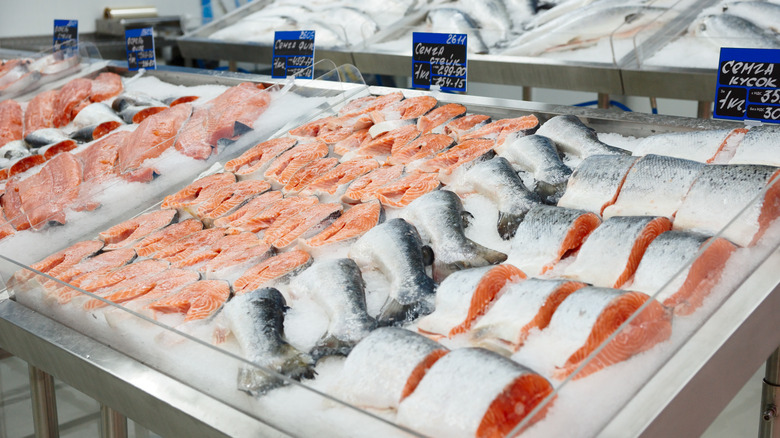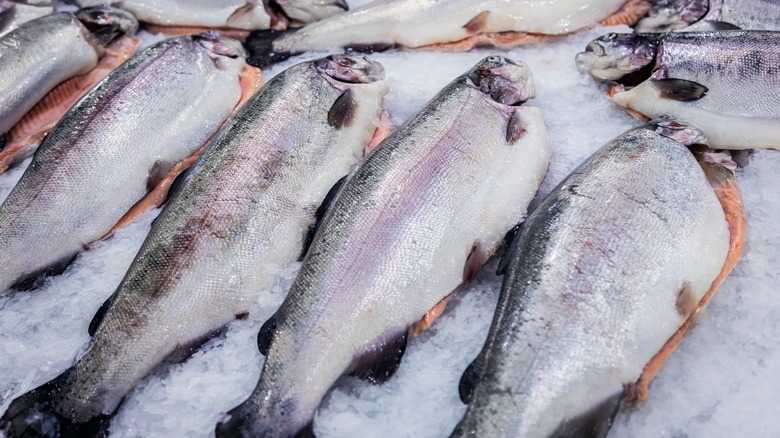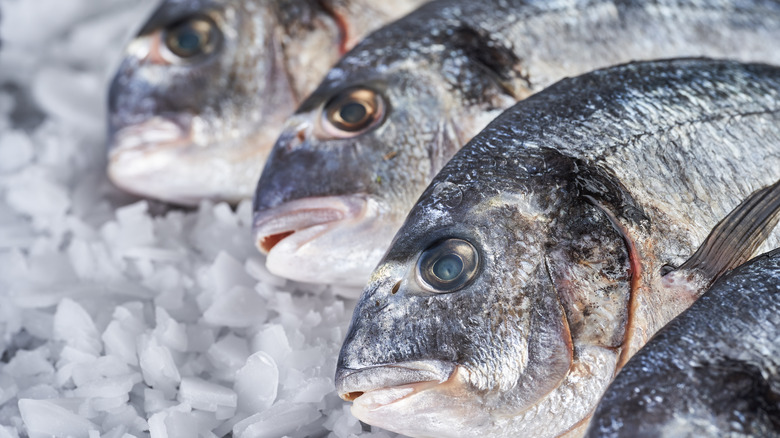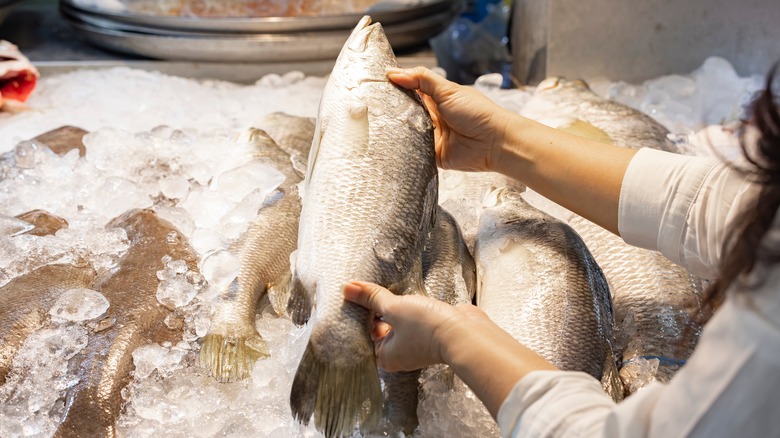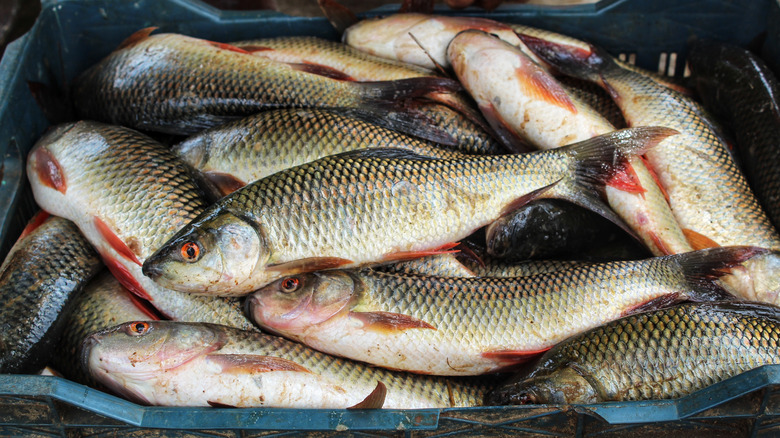8 Important Tips For Buying Fish From The Supermarket
If you're in the supermarket picking out fresh fish, you generally want to ensure it hasn't been sitting on the shelves for too long. Since fish is such a delicate meat, the quality starts heading downhill after only a couple of days, which isn't great for your tastebuds or health.
Cooking up old fish is like opening a can of worms, as they sometimes have a pungent odor that doesn't go away no matter how hard you try in the kitchen. The real danger here, though, is the sneaky germs or other toxins hidden within that can cause food poisoning. This is why getting fish only when they're at peak freshness is the wisest choice — but with them sitting neatly packaged on the store's shelves, it might not be easy to tell the fish's actual state or quality at first glance unless you're an expert.
Knowing what type of fish to buy is also important. Was it raised on a farm? Where did it come from? What kind of food did it eat? All these are important questions to know the answers to, as these factors can affect seafood quality. The first step to picking out top-tier fish from the store is identifying it. As you'll discover below, you'll need all your senses, including sight, smell, and touch, to bring home the freshest catch available and make sure your fish tastes great.
Smell it
Your nose should be your guide as you walk through the seafood aisle of the supermarket. If you catch the scent of a fishy smell that's so overwhelming it makes you hold your breath, you should probably walk away. Generally, freshly caught fish doesn't have a strong fishy odor, so if you're getting one, it's a strong indicator that it belongs in the trash rather than on your plate.
You see, as microorganisms break down the fat and proteins in fish, they create many smelly chemicals. One in particular, trimethylamine (TMA), is responsible for that characteristic fishy smell. However, when fish is fresh from the sea, these chemicals have yet to accumulate, so you shouldn't get those odors. If they're there at all, they should be mild. Admittedly, the presence of a smell doesn't always mean it's gone bad, as some kinds of fish, usually those from the ocean, may have a more intense fishy aroma. Still, it's pretty reliable if you notice this along with other aging signs.
One Reddit user explains, "If the fish is fresh/good quality, it should smell like fresh ocean." You may pick up hints of fresh-cut grass or seaweed as well. The slightly muddy aroma of freshwater fish from the bottom of the lake is another scent to note.
Look at the skin
If the fish passes the smell test, the next step is to observe how it looks to confirm its state before buying. Step back and perform a general examination, reviewing its appearance from the head to the tail fin. This step can give you a good idea of when it was harvested, as well as how it was handled before getting to the shop.
First, note how the skin looks in the light. Fresh fish typically has a shine to it with a metallic tint. This brilliance begins to dull as the days go by, so if it's absent, you know the fish has been in storage for a while. Fish fillets should have a deep, rich coloration, with no darkened or discolored patches, which can be a telltale sign that the fish is going bad. At the same time, packaged fish is sometimes treated with color fixatives to preserve its appearance, so it's important not to rely purely on color.
Look closer too, at the scales on the fish. Are they properly aligned? Or are they all out of place with several bald spots? In prime condition, fish scales are well organized and tightly attached to the flesh. They start loosening up as the fish ages, but other factors like fluctuating temperatures or trauma may cause the fish scales to fall off easily. You should also inspect for cracks and scratches that may be caused by the fish being manhandled, or indicate spoilage.
Check the eyes
You want to look for bright, clear eyes when shopping for fresh fish. The eyes should be bulging with glistening black pupils and a translucent cornea. You also don't want to see mucus on the eyes.
After the fish has been lying around for a while, the eyes start looking different. One of the first apparent signs you may notice is that the corneas and lens aren't as clear, which is a red flag when buying fresh seafood. Fish eyes may lose plumpness over time, appearing like they're sinking into the socket. Other noticeable signs of fish aging are changes in the pupil's appearance, as they sometimes turn gray or white, and a thick layer of yellow slime may develop. Sometimes, cloudy fish eyes may not be caused directly by age but rather by damage during handling, making this another thing to check for.
Do note, however, that a few types of fish, such as kingfish, mackerel, and barramundi, usually come with some degree of cloudiness in their eyes, even when fresh. If they're genuinely fresh, the eyes will remain bright and full despite appearing a little murky.
Inspect the gills
You're not done examining your fish until you've had a good look at the gills. These are the fish's specialized organs for breathing underwater, usually hidden at the sides of their head. In freshly caught fish, the gills don't look much different from when they were alive, so they should be bright red or pink and moist. With time, this color deepens, making the gills appear grey or brown — although aging may also change the appearance of the gills to the opposite end of the spectrum, so they take on a lighter or bleached appearance.
When fish are at their freshest, their gills should look clean, though some fish, like Mackerel and Cod, may have a thin layer of clear mucus covering their gills. You know the fish you're eyeing is past its prime if you see thick, opaque yellow, gray, or brown slime covering its gills. In addition, fish gills shouldn't look or feel completely dry.
Do the touch test
Now's the time to get in there and see what the fish feels like. Texture is such a crucial feature to note, as it generally varies depending on how long ago the fish was caught. At first, it's soft and flexible, but shortly after capture, the muscles begin to tense up as rigor mortis sets in. If you push your finger into the fish flesh during this stage, it should feel firm and bounce back quickly without leaving prints behind — this is the touch test. The flesh should also be firmly attached to the bone, not sliding off easily.
The truth is rigor mortis only lasts for a while, which is why it's such an excellent way to estimate the age of the fish. Anywhere from a few hours to a couple of days later, depending on the fish species and how it was handled, it begins to subside. Since the flesh isn't firm anymore, it would fail the touch test, which might indicate that this fish has been out of water for a long time. This trick isn't a definitive test for every type of fish, as some with naturally soft flesh exist, but it can still point you in the right direction.
Don't focus on wild-caught fish alone.
There's no correct answer when choosing between wild-caught and farmed fish, as it mostly depends on your priorities and preferences. But if you don't want to miss out on delicious gems, don't be too quick to dismiss farmed fish without giving it a fair chance. Although most people favor wild-caught fish, thinking it's better tasting, this isn't entirely true. Farmed fish can be just as delicious, especially if freshly harvested from a high-quality establishment. Letting your creative side shine as you try innovative salmon recipes also helps you make the best of what you've got.
The sustainability angle is another factor that influences people's decisions. Unlike fish caught in the wild, those raised on farms do not reduce the species' population out in nature. Plus, they're more likely to arrive fresh in stores and remain available all year round. Price is a significant distinction between both fish classes, as wild-caught fish puts a deeper dent in your wallet. While many consumers worry about antibiotic use in farmed fish, wild-caught fish carry the risk of heavy metal contamination.
Another factor influencing your choice is how skillful you are in the kitchen. If you're still learning the ropes, one Reddit user advises that you consider farmed salmon as it's "a little more forgiving, whereas wild salmon is quick to overcook." Ultimately, you should tailor your choice to your taste, budget, values, and cooking skills.
Shop local
Buying fish harvested in your region gives you two main benefits: Freshness and sustainability. Since it's not traveling thousands of miles to get to your plate, the odds are good that it's still in the freshest state. Plus, you won't be missing out on prime seasonal harvests. The environmentally friendly angle of buying fish from close to home centers around cutting down your carbon footprint. Just imagine all the resources that go into flying in fish from another country, and all the energy spent on something that may only get to you long after it's past its best.
There's still one more thing to check: Where the fish is processed. One secret you probably didn't know is that fish harvested in the United States may sometimes be flown to another country for processing. Therefore, to ensure your seafood is truly homegrown, you're better off getting it caught and processed as close to you as possible. As a bonus, you get the added sense of security that your food meets strict regulatory standards. Finally, shopping locally isn't just good for your tastebuds — you're stimulating the local economy, too.
Ask questions
If you're not an expert, there's only so much you can do when buying fish to ensure you get the best quality every time. That's why you need your fishmonger's help. They know everything there is to know about what they're selling and are in the best position to help you out if you're ever confused. Don't know what to ask? Try asking when the fish arrived, where it was caught or farmed, and what its diet was like. Plus, You can always ask for more details about the fish merchant if you'd like to know.
Your fishmonger can recommend the best type of fish for those who need help figuring out what to get, which is especially helpful if you're thinking of making a specific dish. On the other hand, if you have no idea what to do with the fish when you get home, you can trust them for the best cooking or storage tips so your purchase doesn't go to waste. Over time, your interactions with your fishmonger help build trust and a lasting connection so that you'll likely get the finest cuts and first-hand information about which fish is freshest.
